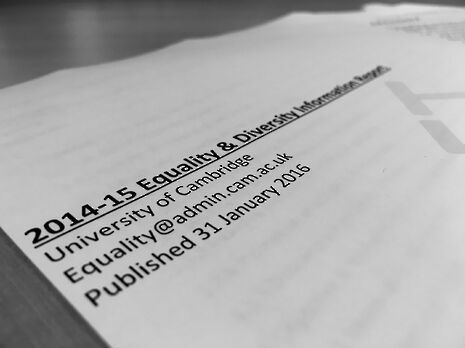University report shows progress on minority representation
The university’s Equality & Diversity Information Report gives new data regarding representation

New data from the university’s Equality & Diversity Information Report shows small increases in representation for women, BME and LGBT+ people, and disabled people within the university.
The report, which covers both students and staff within the university, reflects the most up-to-date statistics upon all issues related to Equality & Diversity.
The percentage of female undergraduate students is lower among those studying subjects in Science, Technology, Engineering, Maths and Medicine (STEMM), at 35.7 per cent compared with 58.5 per cent of those studying Arts, Humanities and Social Sciences (AHSS).
Among prospective undergraduates, there is presently a higher proportion of male applicants, at 54.9 per cent (compared with 45.1 per cent female applicants). More female applicants pass the interview stage – they make up 47.3 per cent of Cambridge’s acceptances, compared with 52.7 per cent who are male. These numbers show an increase in the proportion of females from the year before, in which males made up 56 per cent of applicants, and 57 per cent of those admitted. Across the UK, women are 35 per cent more likely to go to university than men.
The figures for postgraduate admissions show no change from last year – 44 per cent of those admitted were female.
There has been an increase in the overall percentage of undergraduate students getting Firsts, with male students now being nearly nine per cent more likely to get into the top grade boundary than females, at 29.4 per cent of males to 20.6 per cent of females.
There has been an increase in the percentage of non-white students. BME students made up 24.4 per cent of undergraduate students and 33.3 per cent of postgraduate students in 2014-15, compared with 23.2 per cent and 33 per cent respectively the year before.
BME students are more likely to get undergraduate firsts at 22.1 per cent, compared with 21.9 per cent of white students.
968 (8.1 per cent) of undergraduates and 497 (5.9 per cent) of graduates identified as disabled, an increase of 0.1 per cent and a decrease of 0.1 percent respectively.
The proportion of minority groups among staff has increased as well.
There has been an increase in the number of BME staff. Of the 81.2 per cent of staff who disclosed their ethnicity, 11.4 per cent are BME. This is a 0.4 per cent increase on the year before. Of those who identified themselves as BME, the biggest groups were those listed as ethnically Chinese (3.5 per cent), and Asian or Asian British Indians (2.5 per cent).
The highest proportion of non-white staff is amongst researchers, of whom 20.5 per cent are BME.
66.9 per cent of staff are from the United Kingdom. The university states that it does not hold data on the nationality of 16.1 per cent of its staff.
2.9 per cent of staff identified themselves; however, this is out of just 15.6 per cent who responded to the question. Over a third did not specify their disability.
The university states that it holds sexual orientation data for 21.4 per cent of staff. Among these, 6.7 per cent identified as “lesbian, gay, bisexual or other”.
55.6 per cent of staff described themselves as having ‘no religion’. The next biggest group is those who described themselves as ‘Christian’, at 35.3 per cent.
There has been an increase in places filled by women in university governance – from 18.8 per cent of committee members overall in 2012 to 27.5 per cent in 2015. The 10 female staff who attend the University Council make up 50 per cent of its number.
The proportion of women in the roles of Senior Lecturer, Reader and Professor all grew from 2012, increasing respectively by 7.2, 5.4 and 0.9 per cent, to new levels of 37.6, 25.3 and 16.7 per cent. In the case of Professors, this means an increase in real terms from 89 in 2012 to 103 in July 2015. The proportion of women in the role of ‘University Lecturer’ dropped slightly in the same period, from 34.5 per cent to 33.6 per cent. Overall, women make up 28.1 per cent of academic staff at the university.
Women are more prominently found across the faculties of the AHSS, making up 52.3 per cent of all AHSS staff. In STEMM, women make up 46.2 per cent. However, among academics within the faculties there is a lower proportion of women: 38.2 per cent with AHSS, and 20.9 per cent in STEMM.
One area where representation of women remains low is among the Head of General Boards Departments, in which women make up just 11 of the 63 places, according to the University’s “Pyramid of Power 2015”. All six Heads of Schools are currently male.
The university has developed new processes for handling applications for promotion, after studies “appeared to show that while female academics were just as successful as their male counterparts if they applied for promotion, they were less likely to do so”.
Across the university’s 11,086 employees, the report stated that 49.4 per cent (5,471) identified as female and 50.6 per cent (5,615) as male.
The report states that with regards to transgender staff members, numbers disclosed “remain too small to publish but continue to be monitored internally”.
The report also features pay scales for all staff. The proportion of women peaks within the first four pay grades, with 62.1 per cent of those receiving Grade 4 pay (£21,391–£27,864 PPA for the time period covered by the report) being women. The proportion then “decreases through the remaining grades”, with women making up 17.4 per cent of those in the top pay Grade (12), which for 2014-15 covered salaries from £67,411–£173,346 PPA.
Data covering the gender of staff against their age reveals that, after the age of 60 onwards, female staff make up an increasingly low proportion of staff numbers. The average age of staff dropped slightly from 2013/14 to 2014/15, from 42 years old to 40.
 News / Meta opens £12 million lab in Cambridge 11 July 2025
News / Meta opens £12 million lab in Cambridge 11 July 2025 News / Newnham students warned against using ‘secluded or concealed routes’ in evening after student followed16 July 2025
News / Newnham students warned against using ‘secluded or concealed routes’ in evening after student followed16 July 2025 Lifestyle / Reflections on rowing10 July 2025
Lifestyle / Reflections on rowing10 July 2025 News / Write for Varsity this Michaelmas13 July 2025
News / Write for Varsity this Michaelmas13 July 2025 News / University applies for extension to injunction against protesters 15 July 2025
News / University applies for extension to injunction against protesters 15 July 2025









